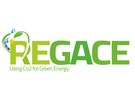In the search for sustainable cultivation systems, many have been looking at agrivoltaics providing a dual use of agricultural land for agriculture and renewable energy production. However, the main hurdle of this tech is getting the balance between electricity and crop production right. This prompted the establishment of the REGACE project, funded by Horizon Europe, which aims to investigate the combination of the TriSolar tracking system with CO2 enrichment. "The TriSolar system is an agrivoltaics, crop responsive solar tracking system installed inside greenhouses whose goal is to optimize growing conditions for plants," explains Dr Esther Magadley from the REGACE project.

"The TriSolar system uses custom-made monocrystalline bifacial PV panels. These panels have a transparent back panel and spaces between cells to ensure even light distribution inside the greenhouse." The system's smart control mechanism adjusts the panels' angles based on plant light needs. Essentially, it's like giving plants the perfect amount of light and shade throughout the day.
"By adding CO2 enrichment, which helps plants grow with less light, we aim to make this technology viable in Northern climates with lower light conditions," says Dr. Magadley. The project installs systems in six locations across Europe and Israel to evaluate their performance from various perspectives.

Crops & electricity
The REGACE project is significant because it offers a solution that increases crop yields and produces renewable energy. According to Dr. Magadley, "The tracking system is attached with a few screws to the greenhouse supports, eliminating the need for extra wind-proof structures and reducing installation costs."
Additionally, this dual-use technology (for crops and electricity) can transform small greenhouse operations into energy producers. The system is tested in various types of greenhouses, ensuring it works with different crops and structures.
The TriSolar system stands out because it responds to the plant's light requirements. Dr. Magadley points out, "It's one of the few systems that optimizes light conditions for plants. By combining this with CO2 enrichment, we aim for higher crop and electrical yields." Plus, the system is installed inside the greenhouse, using the existing structure, which keeps material and installation costs low.

But how does this technology manage to do both? The TriSolar system adjusts the PV panels to ensure optimal light at crop height. "CO2 enrichment compensates for lower light levels, allowing the panels to focus more on capturing sunlight and generating electricity," says Dr. Magadley.
If it's green it's good
The TriSolar system is quite crop-agnostic and can work both in vegetable and flower greenhouses. Dr. Magadley explains, "The system can be adapted for different plants by changing the light requirements in the TriSolar tracking system." So whether you're growing tomatoes or tulips, this tech has you covered.
Developing this technology wasn't without its hurdles. "Balancing electricity and crop production was a key challenge," says Dr. Magadley. The team had to create a mounting mechanism suitable for various greenhouse types, like polytunnels and glass greenhouses, and different coverage ratios. They also developed different semi-transparent PV panels to fit these structures.

The good news is, that installation is relatively straightforward. The system attaches to the existing greenhouse structure. Dr. Magadley notes, "While the technology is still being optimized, the next version will make installation even simpler."
As part of REGACE, growers are supported throughout the installation and use of the technology. Dr. Magadley mentions, "We collect feedback from greenhouse farmers in different countries to help optimize the system further. In a commercial setting, we plan to offer ongoing support to growers."
Who even needs sun?
Originally designed for sunny areas, the TriSolar system is now being tested in various climates through REGACE. "We aim to make the technology suitable for more northern regions with low sunshine conditions by using CO2 enrichment," says Dr. Magadley. The installations range from northern Germany to Israel, covering a wide climatic spectrum.
Dr. Magadley believes that growers outside of Germany will be just as enthusiastic about the project. "The REGACE project results should interest different geographical areas and provide benefits to growers in various regions," she says.

REGACE has six installation sites, including university research centers and working farms: Bio-Gärtnerei Watzkendorf GmbH, an organic farm in North Germany; Humboldt University of Berlin, Germany; Fattoria Solidale del Circeo, a social farm in Italy; University of Natural Resources and Life Sciences, Vienna, Austria; University of Thessaly, Greece; AlZahrawy Society, Research Center, Israel.
The project has 18 months left to collect and analyze data, which will inform recommendations for technology implementation in different countries. If proven viable, REGACE has the potential to offer a valuable agrivoltaic solution for greenhouses worldwide. Perhaps, your next greenhouse-grown veggies might just come with a side of solar power.
For more information:
Regace
regaceproject.com
